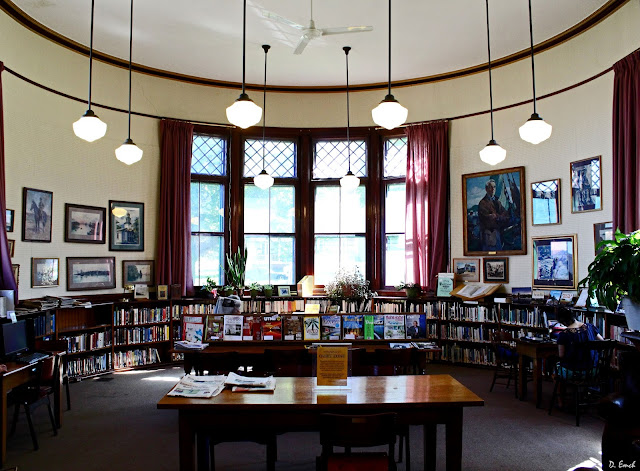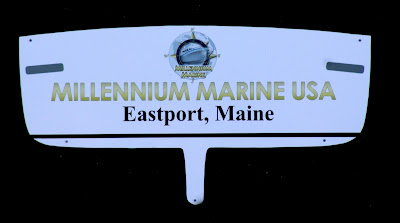Welcome to Eastport Maine, the easternmost city in the United States. Eastport, with a population of around 1300, is situated on Moose Island. The island was used as a fishing camp in the 1600's and settled in 1772. As we will see over the next few days, this is a town that has had to overcome much adversity and reinvent itself numerous times over the last few centuries. In fact, it is going another such reinvention right now. Today we will get a first glimpse of some of the areas history and some of its current revitalization efforts.
Although it is a rare occasion for the water surrounding Eastport to freeze over (the St. Croix River, the Bay of Fundy, the Passamaquoddy Bay and Cobscook Bay,) it deals with a harsh winter. One local said that in this area of Maine there are nine months of winter and three months of bad skiing. A total of sixteen feet of snow fell on the town this last winter, snow that just continues to pile up as there are no winter thaws here.
Although there are various aspects of the town sprawled across the 12 square miles of the island, most of it is centered alongside the waters on the eastern side of the island.
Picturesque sites abound, and many of the homes hug the cliffs alongside the edges of the island.
The area has a rich history, changing hands from the French to the English to the United States, back to the British and then back to the United States again.
There wasn't much military action to speak of here. There was an old fort that was surrendered to the British in the War of 1812. The Brits came with an armada and a couple of thousand men to capture the place. Much to their consternation it turned out there were only a few dozen Americans in the fort and most were sick when they arrived. The American commander blustered for a day, saying he would fight to the last man, but the townsfolk (located between the fort and the harbor) convinced him it was silly to bring on a bombardment when a quick defeat was inevitable.
In many ways the history here is much like What we saw on Amelia Island in Florida. Smuggling was an honorable livelihood, with smugglers alternately having the blessing of one country or another. At one point the local ships were flying Norwegian and Swedish flags to be able to claim neutrality as they kept the flow of goods going. At one point the United States sent in a bunch of gunboats to stop it, but thousands of barrels of flour, plaster and other goods continued to flow. There are old accounts of flour that was purchased for twenty five cents a barrel being resold for twenty five dollars a barrel in neighboring Canada or down in the West Indies. There are a few accounts of piracy, but nowhere near the extent that it existed in the South.
An average vertical tide change of over twenty feet in the area allowed for ships to easily move throughout the waters. But this much water moving in and out twice a day creates unique challenges. Docks and break waters are extensive structures. The Bay of Fundy has the biggest mean tide changes on earth, averagine 32 feet in some areas. These huge tides got the attention of Franklin Roosevelt and the Army Corp of Engineers back in the 1930's. The proposed to build a huge tidal driven electrical generation facility, and actually completed a good bit of work before the project was abandoned.
One of the first things they did was build a large causeway out to the island. The causeway runs from the heart of the Quoddy Indian Reservation out to the island, which causes some concerns that we will address in another article. Suffice it to say that it dramatically changed the water flow and the migration patters of sea life in this area.
The Corp of Engineers planned to build a whole town to house folks that would maintain the generation plant.
Large officer's quarters, dining facilities, bunk houses, warehouses and numerous houses were built.
I found conflicting reports on what the underlying cause of the project's termination was, but the money dried up and the buildings were left abandoned.
A few buildings and quonset hut clusters remain.
An old sign adorns the walls of one of the structures - I am surprised one of those antiques road-show guys hasn't gotten ahold of it yet.
But most of it has fallen into ruins.
As I was photographing this building, a fellow approached me and asked me if he could help me. I replied that I was just taking photos. He persisted by asking if I was from Maine. I replied that I wasn't. Finally he said he wasn't used to people he didn't know walking around his property. Upon hearing this I apologized immediately - I had assumed that this was just a neglected ruins and had no idea someone lived here.
Jim Guertin
Jim Guertin bought the property 23 years ago for $10,000 and has lived in it since. Luckily, (unlike the fellow with a shotgun that ran me off from an old barn in Kentucky a while back) he was friendly and shared what he knows of the area's history.
In many ways, Eastport's current local cultural hub is the community library, where at any time of the day one can find local clubs meeting and folks reading and studying various topics. It is an attractive building that was constructed and gifted to the town in the 1890's by one of the town's sons who had gone west and had much financial success.
Many civic groups meet here, and there is a strong "friends of the library" group that works to maintain its vitality.
The man who built it was one Frank Peavey.
Frank Peavey
Frank, born in Eastport in 1850, suffered the loss of his father when he was 9 years old. At 15 he had saved a bit of money from working and moved to Chicago. Arriving with one dollar, he found employment selling newspapers, as a messenger boy and then as a clerk in a bank.
He was highly regarded for his work ethic, and given a position with a farm equipment sales firm. In short order he founded his own firm with two partners, and then bought both of them out. A fire wiped him out and left him deep in debt, but he reestablished himself and paid off every dime.
What made him unique at the time was that he was willing to trade directly with the farmers - implements for their wheat. Not only did this cut out some middleman, it earned him a loyal customer base. He ended up with grain warehouses all over the midwest, and at one point controlled more wheat than anyone in the world. He died at age 51, but before he did he made sure that he gave something back to the town that had reared him.
Dana Chevalier has been the librarian for 13 years, and was a big help as I sought old books on various topics.
As a side note, there is one of those little "free libraries" along the waterfront - the last one of these We saw in Bluffton SC.
A fascinating topic which many books in the library are devoted to is the history of shipbuilding on this island.
It all started when a fellow named John Shackleford built a few fishing schooners here in 1787. But the United States and Canadian borders were not well established by the Revolutionary war - in fact that all wasn't sorted out until forty years later after the war of 1812.
As the US and the English imposed various embargoes on trade, the ships became more valuable as merchant and contraband runners than fishing vessels. The port became so successful that several years it had more ships in and out than Boston, and almost matched New York a few times.
Ship building prospered here, with boats built in East Port being in demand world wide. The Grey Feather, a 138 foot sloop built here in 1830 was the first of a long line that set and held many world-wide sailing records. Ship builders from other areas came here to have the masts and rigging outfitted on their boats, and it was a very desirable place for ships to seek repair.
Through the civil war the industry continued to surge - a boat building academy was established here and in the 1870's a boat design called the "Eastport Pinkie" became the boat of choice for many in the fishing industry.
During the late 1800's the steam engine made its debut, much scorned by the sailors of the day. As this became the preferred method of powering boats the boat building industry here began to die. It still had some remnants up through the 1970's with a few factories that built working boats, but the boat building industry in Eastport died thirty years ago.
But two years ago an event happened that may have returned the tides of fortune for this industry with the opening of Millennium Marine USA.
A third generation boat builder named Cory Guimond from Canada decided to open up shop in an old warehouse just outside town.
Cory relocated here from Escuminac Canada. He started building wooden boats with his father in 1995, and took the company over shortly thereafter when his father died. He has since moved to fiberglass boats, but he hopes to one day teach his 7 year old son the dying art of wooden boat building.
It all starts with big molds that are used to shape the hull.
The molds are split into two halves that are on rollers, so the whole contraption sort of resembles a giant clam shell.
First goes down a few layers of wax and the layer that will be the finished exterior of the boat. Atop this 4 layers of fiberglass matting is laid down, each one adhered to the next layer with resin. The resin comes in fifty five gallon drums and the rolls of fiberglass come on pallets.
The hulls are then moved out of the molding area into the finishing area, where they are sanded and painted.
About half of the hulls built here will be fully fitted out here - with the roofs put one, the engines installed, the cabins finished, the plumbing in, electronics wired, handrails and ladders installed and all the other things that need done before this boat can go to work.
The other half of them are "kits" - hulls that they build, and then along with the roof and side rails ship off to other factories that will do the finishing work.
Today one of them is being moved to a local boat ramp so that it can be towed to a finishing plant in Canada. Cory has built a unique six wheel dolly to carry the weight of the back of the hull as it is towed along with a tow motor. A local police car waits to escort it along its way to a dock a few miles down the road.
This is what this hull will look like when it is fitted out.
Once in the water, it awaits a tug to pull it to its next destination. Some of these are shipped out by truck - it can cost as much as sixty thousand dollars to transport one of these to the west coast.
Cory has a line of 36 foot pleasure boats coming out soon, and expects that within the next five years he will be employing fifty to sixty people. With three or four boats already rolling out of here a month, it is more than a modest start back for an industry that was once legendary here.
As another side note - the photo above was taken at about low tide, and I was about a third of the way down the boat ramp. Here is the same pier a few hours later with the tide all the way in.
That brings us to today's "Faces in the Crowd."
This fellow, a 78 year old named Heyward, was sifting through a pile of debris for boards to make a tailgate for his new trailer out of.
And today's parting shot, taken at the exit of a local campground:
Click Here if you can contribute a few dollars to help me along with this project and Click Here to email me.
Make it a great day !!
David





































No comments:
Post a Comment